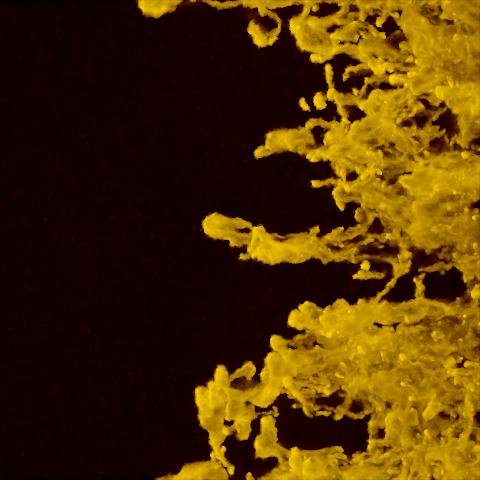Triggered Star Formation
Simulations with IVINE by Matthias Gritschneder
Recent observations with the Spitzer Space Telescope show clear evidence that star formation takes place in the surrounding of young massive O-type stars, which are shaping their environment due to their powerful radiation and stellar winds. In this work we investigate the effect of ionising radiation of massive stars on the ambient interstellar medium (ISM): In particular we examine whether the UV-radiation of O-type stars can lead to the observed pillar-like structures and can trigger star formation. We developed a new implementation called IVINE, based on a parallel Smooth Particle Hydrodynamics code (VINE), that allows an efficient treatment of the effect of ionising radiation from massive stars on their turbulent gaseous environment. In the simulations we address the effect of ionising radiation impinging plain-parallel on a box (2 parsec) of turbulent medium. We choose the initial conditions to mimick observed turbulence in the ISM. This turbulent medium with typical velocities of Mach 5 is exposed to ionising radiation. The UV-radiation is impinging from the negative x-direction and leads to a rapid ionisation of the first ~5% of the cube before the medium reacts to the increased temperature of the ionised gas. This is comparable to the situation at the border of the Strömgen sphere a few parsec away from a hot O-star. When the UV-radiation is switched on, it traces the turbulent density distribution, reaching further into the low density regions, and less far in the regions of high density. After a dynamical timescale the hydrodynamics react to the increase in temperature, shock fronts evolve and compress the gas while at the same time increasing the turbulent energy of the cold gas. During this phase a typical morphology evolves. The denser regions shadow regions behind them whereas in lower density regimes the radiation can propagate much further. After the first phase of maximum compression a more quiescent phase of evaporation sets in. The densities are not as high as before, but the structures become even more clear. This leads in the final stage to filamentary, pillar-like substructures, pointing towards the source of radiation. The structures contain high density regions in their tips. These a very likely to become gravitational unstable after a free fall time. For further reading download Gritschneder et al. 2009. Click on the image to see the movie.
